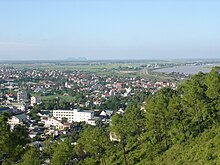Vinh
| Vinh | ||
|---|---|---|
|
|
||
| Basic data | ||
| Country: |
|
|
| Province : | Nghệ An | |
| ISO 3166-2: VN : | VN-22 | |
| Coordinates : | 18 ° 40 ′ N , 105 ° 40 ′ E | |
| population | ||
| City residents : | 226,000 (2002) | |
| Further information | ||
| Time zone : | UTC +7: 00 | |
| administration | ||
| Website: | www.vinhcity.gov.vn | |
Vinh is a city in Vietnam . It is located in the northern half of the country and is the capital of Nghệ An Province . The Vinh population was estimated to be around 490,000 in 2016.
history
Vinh was initially known as Ke Van. It was later renamed Ke Vinh, Vinh Giang, Vinh Doanh, and then Vinh Thi. In 1789 the official name became Vinh, probably under European influence. The name has not changed since then.
Vinh had considerable military and political influence at various times. The Vietnamese nation began in the north and only gradually expanded into its present-day territory. Because of this, Vinh was sometimes seen as the “gateway to the south”. It is believed that the Tây Sơn dynasty (1788–1802) considered making Vinh the capital of Vietnam, but the dynasty's short time made it impossible to carry out these plans. However, due to the interest in Vinh, the city developed well and there was considerable construction. During the French occupation of Vietnam, Vinh was further developed as an industrial center and became known for its factories.
There used to be some historical monuments in the city of Vinh, for example an ancient citadel. Then Vinh was badly damaged in several wars. In the 1950s, a large part of the city was destroyed by fighting between French colonial forces and the Việt Minh . Further damage was caused by the US bombing during the Vietnam War . Vinh or the port of Cua Lo was considered the starting point of the Ho Chi Minh Trail and was systematically bombed for this reason. Little is left of the original city. The reconstruction was strongly influenced by ideas from the Soviet Union and the GDR about urban planning - the city is known for its wide streets and rows of residential buildings, some in the GDR prefabricated building style (Quang Trung district, now heavily slummed, but since around 2005 under renovation or new construction.).
Vinh and the areas surrounding the city have historically been important centers for rebellion and revolutionary activity. In the 19th and early 20th centuries, the city was the center of several prominent uprisings against the French. In addition, a number of distinguished revolutionaries were born in or near the city, including Phan Boi Chau , Le Hong Phong , Nguyen Thi Minh Khai and Ho Chi Minh itself. Ho Chi Minh's birthplace, which is about 14 kilometers west of Vinh, is the birthplace of many Vietnamese a major tourist attraction.
The city of Vinh has been the focus of German development cooperation for many years, which was already started by the GDR.
economy
The service sector makes up most of the economy, with around 55% of the working population, followed by industry (around 30%) and agriculture, forestry and fishing (around 15%). Vinh is an important transport hub with a key position on the route between the northern and southern parts of the country.
traffic
Vinh has good transport connections in all areas to the centers in the north and south. Via the road, the so-called Highway 1, Vinh is directly connected with the capital Hanoi (approx. 304 km) in the north and with Ho Chi Minh City (approx. 1415 km) in the south. From Vinh a connecting road goes about 90 km to the border to Laos . This makes Vinh the most important northern port city for Laos with a direct road connection to Vientiane.
The city is the station of the Reunification Express on the north-south railway line Hanoi - Ho Chi Minh City. Small combined passenger / freight trains also run from Vinh through the northern mountains to Don Hoi , which also stop at small train stations and stops.
The airport Vinh is about five kilometers north of the city is located by the two national carriers Vietnam Airlines and Jetstar Pacific Airlines fly. Vietnam Airlines flies from Hanoi and Ho Chi Minh City to Vinh, Jetstar Pacific Airlines only from Ho Chi Minh City to Vinh.
For smaller ocean-going ships, Vinh is the port, which is also the transshipment port for goods to Laos.
Attractions
Other tourist attractions include Hong Son Temple and Mount Quyet . Hong Son is one of the few large temples that was not closed by the communist authorities after the war and is the site of an important festival on the 20th day of the eighth month of the lunar calendar. Mount Quyet offers an opportunity for retreats from city life. From the top, which can be reached after 400 steps, you can see the whole of Vinh, along with the river and the surrounding fields. The mountain is covered with pine trees, although the forest has not yet fully recovered from the bombing during the war.
Other attractions include the Nghe Tinh Soviet Museum (reminiscent of the Nghe Tinh revolt against the French in the 1930s) and the Cua Lo Beach Resort (a popular vacation spot for Vietnamese people). The Ho Chi Minh Park in Vinh houses the country's largest statue of the revered "Uncle Ho", it is used intensively by the population, especially in the evening hours.
Also worth seeing is the birthplace of Ho Chi Minh ( Kim Lien ), which can be reached quickly by car. Also recommended is the well-preserved, traditional home of the famous Vietnamese poet Nguyễn Du , about 15 kilometers from Vinh.

